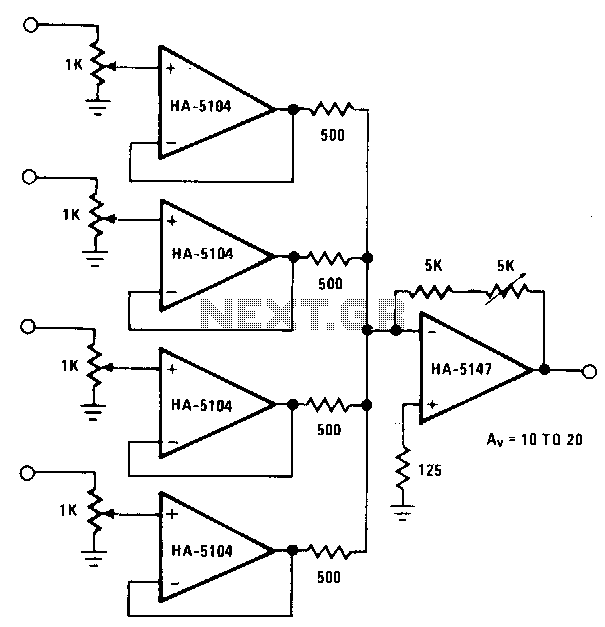
Input-buffered-mixer

A high signal-to-noise ratio is crucial in signal construction and combination. The HA-5147 helps to reduce overall system noise, thereby increasing system sensitivity. The signal combination circuit includes input buffering along with several other features to create an efficient mixer stage with minimal channel crosstalk. Each channel is equipped with a potentiometer that allows for variable input levels while maintaining a constant impedance for the driving source. Additionally, the buffers primarily serve to prevent reverse crosstalk through the resistor network. This buffering enables the combination of signals with varying strengths without reverse contamination. The gain of the final stage is set at a minimum of 10 and can be adjusted up to 20, providing significant flexibility when integrating a wide range of input signals.
The HA-5147 is an integrated circuit designed to enhance the performance of audio and signal processing applications by maintaining a high signal-to-noise ratio. This is particularly important in environments where multiple signals are combined, as it mitigates noise interference and improves the clarity of the output signal. The input buffering stage is critical, as it isolates each input channel, thereby preventing crosstalk that could degrade signal integrity.
The mixer stage is designed to handle various input levels efficiently, with the potentiometers allowing for fine-tuning of each channel's input. This feature ensures that the mixing process can accommodate signals of different amplitudes without introducing distortion or imbalance. The fixed impedance presented to the driving source also ensures optimal power transfer and minimizes signal loss.
The buffering mechanism is key to maintaining signal fidelity. By isolating the input signals, the circuit prevents unwanted feedback through the resistor network, which can lead to signal degradation. This is particularly beneficial in applications where multiple sources may be connected simultaneously, as it preserves the quality of each signal.
The adjustable gain feature of the final stage adds versatility to the circuit. With a minimum gain of 10 and the ability to increase to 20, the HA-5147 can adapt to a wide range of input signal strengths, making it suitable for various applications, from professional audio mixing to instrumentation. The design ensures that the system can handle both weak and strong signals effectively, providing a robust solution for signal combination tasks.A high signal-to-noise ratio is important in signal construction and combination. The HA-5147 aids in lowering overall system noise and thereby raises system sensitivity. The signal combination circuit incorporates input bufferiug with several other features to form a relatively efficient mixer stage with a minimum of cham1el crosstalk. The potentiometer used for each channel allows for both variable input levels and a constant impedance for the driving source.
The buffers serve mainly to prevent reverse crosstalk back through the resistor network. This buffering allows for the combination of varying strength signals without reverse contamination. The gain of the final stage is set at a minimum of 10 and can be adjusted to as much as ZO. This allows a great amount of flexibility when combining a vast array of input signals. 🔗 External reference
The HA-5147 is an integrated circuit designed to enhance the performance of audio and signal processing applications by maintaining a high signal-to-noise ratio. This is particularly important in environments where multiple signals are combined, as it mitigates noise interference and improves the clarity of the output signal. The input buffering stage is critical, as it isolates each input channel, thereby preventing crosstalk that could degrade signal integrity.
The mixer stage is designed to handle various input levels efficiently, with the potentiometers allowing for fine-tuning of each channel's input. This feature ensures that the mixing process can accommodate signals of different amplitudes without introducing distortion or imbalance. The fixed impedance presented to the driving source also ensures optimal power transfer and minimizes signal loss.
The buffering mechanism is key to maintaining signal fidelity. By isolating the input signals, the circuit prevents unwanted feedback through the resistor network, which can lead to signal degradation. This is particularly beneficial in applications where multiple sources may be connected simultaneously, as it preserves the quality of each signal.
The adjustable gain feature of the final stage adds versatility to the circuit. With a minimum gain of 10 and the ability to increase to 20, the HA-5147 can adapt to a wide range of input signal strengths, making it suitable for various applications, from professional audio mixing to instrumentation. The design ensures that the system can handle both weak and strong signals effectively, providing a robust solution for signal combination tasks.A high signal-to-noise ratio is important in signal construction and combination. The HA-5147 aids in lowering overall system noise and thereby raises system sensitivity. The signal combination circuit incorporates input bufferiug with several other features to form a relatively efficient mixer stage with a minimum of cham1el crosstalk. The potentiometer used for each channel allows for both variable input levels and a constant impedance for the driving source.
The buffers serve mainly to prevent reverse crosstalk back through the resistor network. This buffering allows for the combination of varying strength signals without reverse contamination. The gain of the final stage is set at a minimum of 10 and can be adjusted to as much as ZO. This allows a great amount of flexibility when combining a vast array of input signals. 🔗 External reference